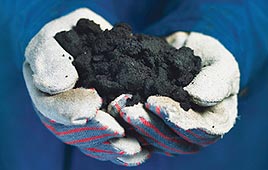Weizmann Institute of Science scientists have developed an efficient way to extract highly viscous oil soaked in huge deposits in the northern sands of Alberta, Canada. Thus, large amounts of oil can be extracted from the sand
Weizmann Institute
Ideas, like good stories, live forever. They are not limited to the duration of a person's life, and sometimes, an idea that arises in one generation is realized in another. This is exactly what happened to the idea that came to the mind of Prof. Norbert Berkowitz, the father of Prof. Brian Berkowitz from the Department of Environmental Sciences and Energy Research at the Weizmann Institute of Science.
which extracts oil from the sand
Berkowitz Sr. was a well-known coal chemist at the University of Alberta, in Edmonton, Canada. In the northern part of Alberta there are huge deposits of very viscous oil soaked in sands. The high viscosity of the oil, which is more similar to tar, does not allow it to be pumped and pumped. To turn it into a liquid, the oil must be separated from the sand and diluted using solvents, or large amounts of diluted oil must be added to it. Only at this stage can the oil be flowed through pipelines, hundreds and thousands of kilometers away to the refineries. These are expensive processes, which call into question the feasibility of utilizing this entire energy source.
Berkowitz Sr. thought of a way that would allow converting the oil tar into flowing oil efficiently, and at a relatively low price. Together with his partner, Steven Dunn, he applied for a patent for the process in Canada. But before he could try the idea in the laboratory, he was killed in a fatal car accident in which his wife, Sheila, was also killed. After the accident, Berkowitz Jr. decided to continue developing his father's idea, until it came to fruition. This decision led him to a strenuous and fast journey of acquiring knowledge in the chemistry of oil. In this context he read three books written by his father. "A magical and painful experience at the same time", he recalls.
After acquiring the theoretical knowledge, it was time to build a system to test the method in the laboratory. Two and a half years were required for the design of the experimental facility and its construction, work in which Berkowitz collaborated with Dr. Yishai Dror, who was then a postdoctoral researcher in his laboratory. "This is elite sewing," he says, "we had to design every item in the system ourselves. After that, we had to adjust the system: 'cooking' the tar for too long causes the formation of 'coke' - a type of poor coal, instead of flowing oil." More than once, the scientists found themselves covered in oil, the result of explosions in the system, which, among other things, necessitated the re-whitening of the laboratory walls. After long sleepless nights came one night the moment when, as the scientists describe it, "the oil began to flow like milk".
The process is based on the use of water heated under pressure. In the past, it was known that a hot "supercritical" liquid (found in the phase of transition from a liquid accumulation state to a gas state) may be used for the partial decomposition of oil or thick oil. Prof. Brian Berkowitz, who continued the scientific path of his father, Prof. Norbert Berkowitz, found a way to implement this phenomenon.
When water is heated under pressure, its boiling point rises, so that the water remains in a liquid state even when its temperature rises well above one hundred degrees Celsius. When they are heated even more and reach the state of a supercritical fluid, they are characterized by some unusual properties. For example, oil and petroleum are insoluble in water and steam, but they are well dissolved in supercritical water. In the case of the viscous oil from the oil sands, the supercritical water reacts chemically with the long hydrocarbon chains that cause viscosity, breaking them down into shorter chains that flow easily.
Berkowitz Sr.'s original patent has now been supplemented by another patent by Berkowitz Jr. and his research partners. The "Knowledge" company of the Weizmann Institute of Science, which is engaged in promoting commercial industrial applications based on the inventions of the institute's scientists, recently submitted an application for the registration of this patent in several countries. Oil-soaked sands and other fossil fuels, which can be rehabilitated using this method, are found in Canada and other countries.

